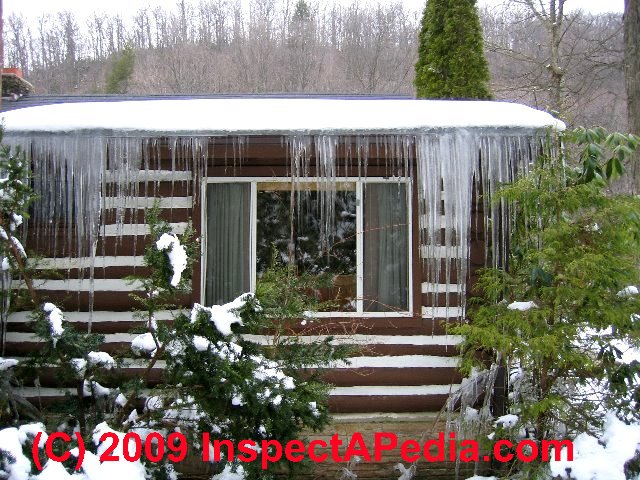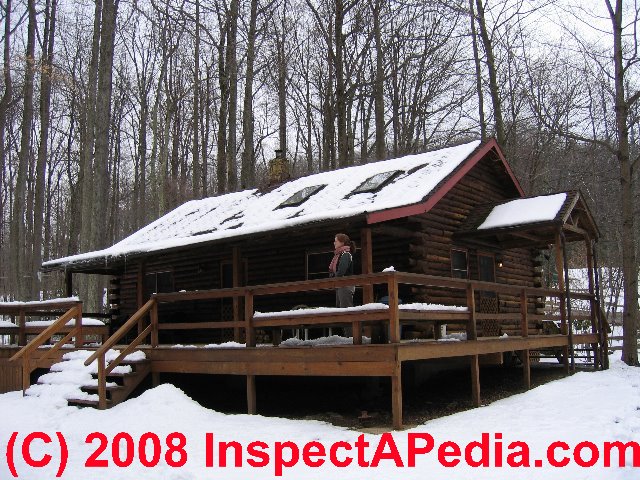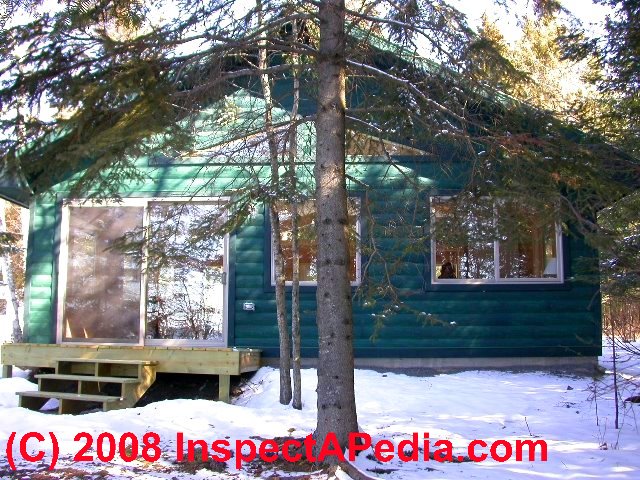 What is the Energy Efficiency of Log Homes?
What is the Energy Efficiency of Log Homes?
- POST a QUESTION or COMMENT about the energy efficiency and heating or cooling costs of solid log home walls.
Log home & log wall insulating properties:
This article describes the insulating and heating properties of log homes, comparing solid log structures, slab-sided log homes, and conventionally framed homes.
This series of articles provides information on the inspection and diagnosis of damage to new and older log homes and includes description of log house and log siding insulation values and alternatives, and also a description of the characteristics of slab-sided log homes as well as all other types of log home construction.
We include illustrations of log structures from several very different areas and climates in both the United States and Norway.
Our page top photo shows a modern kit log home constructed in New York State.
InspectAPedia tolerates no conflicts of interest. We have no relationship with advertisers, products, or services discussed at this website.
- Daniel Friedman, Publisher/Editor/Author - See WHO ARE WE?
What is the Energy Efficiency of Log Homes?
The question-and-answer article below paraphrases, quotes-from, updates, and comments an original article from Solar Age Magazine and written by Steven Bliss.
Question and Answer: Comparison of Energy Efficiency of Log Homes with Wood Framed Homes
Question: Log Homes, All Bark?
We are planning to build a new home in several years and want our project to be totally successful and energy efficient.
We have always had leanings towards rustic structures and have almost settled on a log building. All the manufacturers of log buildings stress their tremendous energy efficiency.
Confused about log home energy efficiency would be describing our state lightly. Have you ever done a study of the energy efficiency of log structures or compared a log home's energy costs with a conventional, highly-insulated structure?
Answer:
Although log home manufacturers would like the public to believe that log homes are highly energy-efficient, they have not yet impressed us. While any home can be made energy efficient with enough insulation and tightening up the building envelope, log houses have some built-in energy inefficiencies.
Questionable Log Wall R-Values
First, wood by itself is a poor insulator, at about R-8 for a 6-inch-thick (average) cedar log wall. [Have you noticed that the thickness of a curved round-log wall or a half-curved D-log wall is not uniform in thickness? A nominal 8-inch solid log wall made of rounded logs has an average 6-inch thickness.] Insulation must be added to such a solid log wall even to bring it up to the R-11 insulation value of a standard 2x4 wood framed stud wall insulated with fiberglass batts.
Of course you can't add insulation to a solid log home without diminishing some of the log house's original rustic appeal on the inside or outside. Also, adding insulation inside will lose the comfort benefit of thermal mass of the logs.
We discuss these factors in detail at LOG HOME WALL INSULATION VALUES.
Log Home Wall Air Leaks
Second, log houses invite air infiltration because they have many yards of between-log gap. It is true that log home manufacturers have come up with ingenious log wall gasketing that should stop air infiltration leaks between logs, but if you are looking for energy-efficiency, why not choose a design that does not have such a large air infiltration problem to be solved in the first place.
[DJF Note: our experience with both building and inspecting/diagnosing log homes indicates that too often, especially with owner-built kit log homes, errors and omissions in the gasketing system are responsible for serious air and sometimes water leaks in the log home's walls.
Similar problems occur around windows if they are not properly installed and sealed.
See Leak Diagnosis & Cure for Log Houses for details.
Readers whose homes are drafty, leaky, or otherwise too cold and who have high heating bills should also see these air leak articles:
Log Homes Have Thermal Mass
Solid log homes are more massive than lightweight wood-frame insulated structures, but a National Bureau of Standards study found that the energy that a log home saves in the swing seasons (spring and fall) through added mass (and comfort for occupants by heating or cooling systems needing to cycle on or off less often) does not amount to much on an annual basis.
A slab-log sided home (see our photographs just below) looks like a log home on its exterior, but is built with conventional wood framing that permits high wall insulation values; this design also avoids the log home wall air leak problem.
This highly-insulated log home alternative gives up the interior beauty of solid log walls, gives up the comfort of thermal mass, but gains high energy-efficiency and low heating costs. See Slab Log Cabin Siding for details.

The above question-and-answer article about the energy efficiency and comparative heating and cooling cost of log homes compared with conventional wood frame structures, quotes-from, updates, and comments an original article from Solar Age Magazine and written by Steven Bliss.
Here we include solar energy, solar heating, solar hot water, and related building energy efficiency improvement articles reprinted/adapted/excerpted with permission from Solar Age Magazine - editor Steven Bliss.
Overcoming drafts and un-wanted air leaks is the first priority for making a building comfortable and for reducing heating or cooling costs in cold climates.
INSULATION R-VALUES & PROPERTIES provides detailed estimates of the insulating values and properties of various insulating materials.
Readers should see R-VALUES & THERMAL MASS in LOG HOMES, and
see LOG HOME WALL INSULATION VALUES where we compare the typical insulation values of a log home with a conventional wood framed structure, and where we include a discussion of the effects of thermal mass of log homes, providing also typical solid log wall home R-values.
That article also explains the insulation and energy efficiency character of log-slab-sided conventional wood-framed homes.
Original article
The link to the original Q&A article in PDF form immediately below is preceded by an expanded/updated online version of this article.
- Q&A on the energy efficiency of log homes: Log Homes: All Bark? - PDF version, Use your browser's back button to return to this page
...
Reader Comments, Questions & Answers About The Article Above
Below you will find questions and answers previously posted on this page at its page bottom reader comment box.
Reader Q&A - also see RECOMMENDED ARTICLES & FAQs
Comment: log home builder comments on energy efficiency & comfort of log homes, gripes about log home issues.
(Feb 20, 2013) Matt Davidson said:
hi i am a handcrafter of log homes. ok,i admit log homes are not built to r 2000 standards, nor will they ever be. they are getting better though. The industry knows what people demand. the industry is getting better all the time.
as a builder, i do not try to sell our handcrafted product as the most energy efficient building money can buy.
they are very comfortable though when built correctly, and we do. it seams to me you are painting us all with the same brush, professionals and do it your selfers alike. your pictures are bias to prove your point. what you dont mention about the shack in the top picture is that this happens to framed buildings as well. that picture is not an example of poor log construction as much as it is a fine example of poor roof insulation,vapour barier and air ventilation. editor, i dont know if you noticed but the roof in your picture is not made of logs!
i dont see icicles coming our of the log wall! a little honesty would be nice. how about the fact that wood has the highest r value of any natural product, the fact that a log home sequesters carbon, and that a properly built log home(not like the drafty shacks you show) can last for 800 years(as they have in Europe)! they are built form a sustainable renewable resource. that is good for the environment period. put fiberglass up against that track record.
i do not dispute the fact that log r values are lower per inch than foam, mineral wool,or fiberglass, but even these insulation products fail miserable when installed wrong (as your picture proves). i resent the fact that you speak about a construction industry you obviously know nothing about.
Matt Davidson
Davidson Log & Timber Artisans Inc.
Mr. Davidson is a log home builder in Ontario, Canada. He can be contacted at - [Ed.]
Davidson Log & Timber Artisans, Inc.
54 Rama-Dalton Boundry Rd.
Washago, ON L0K 2B0
Canada
(705) 833-1203
info@davidsonloghomes.comReply:
Thanks Matt.
We appreciate hearing your opinion; we also welcome critique, content suggestions, citations and references, and objective data that makes all of use smarter.
It is useful to separate aesthetics, perceived comfort, actual energy costs, durability, and other factors for log homes as well as other types of construction, and at least as important to separate opinion from objective data or facts. Certainly taking an experienced look at a building after it has been in service for a decade can give us a dose of "real world" data.
Both the original author, Steve Bliss, and I (InspectApedia editor) have constructed log homes, and in my case, inspected hundreds of them in various parts of the U.S., Canada, The U.K., Norway, Spain and Germany.
I have sene a wide range of experience and expertise among log home builders, with a concomitant variation in energy efficiency, comfort, leaks, operating and maintenance cost, durability, and yes, even rot.
At a ten year old log home I foundleaks at every window and predicted future rot: none of the windowshad been properly installed, all using makeshift inserted frames, no splines, no sealant. The builder, who was at the inspection, was surprised at my concern. He had been building log homes for a decade and "... had never seen any rot"
"Where is the first log home you built?" I asked. [Note: this builder was a New York log home builder, he was NOT Mr. Davidson who commented above - Ed.]
"Nearby, I live in it. Let's go over there" he suggested.
The home was beautiful, in a shady wooded glen in a country setting. Together we walked around to the rear of the home, a shady spot where I suspected a low roof eave might also suffer from overspilling gutters, rain splash, or other worries. I could see water stains and punky looking wood at the builder's log home bedroom window. Using just my bare hand, I reached out and grabbed a handfull of rotted log at the lower corner of the window. I could stick my fist into the wall.
The builder, like so many in our field, had good intentions, was a great craftsman on some topics and not so expert on others, and like many of us, didn't make those distinctions. The builder, whos opinions were as vehement as Matt's (above), had never actually gone back to his homes a few years later to see how they were doing.
Matt this article may be of interest to you: LEAK DIAGNOSIS & CURE in LOG HOMES
...
Continue reading at INSULATION R-VALUE, SOLID LOG WALL or select a topic from the closely-related articles below, or see the complete ARTICLE INDEX.
Or see these
Log Home Articles
- LOG HOME GUIDE
- AIR LEAK DETECTION TOOLS
- ANTIQUE & OLD LOG CABINS
- CRACKS CHECKS SPLITS in BEAMS, LOGS & POSTS
- ENERGY EFFICIENCY of LOG HOMES
- INSULATION R-VALUE, SOLID LOG WALL
- KIT HOMES, Aladdin, Sears, Wards, Others
- LEAK DIAGNOSIS & CURE in LOG HOMES
- LOG HOME CONSTRUCTION
- R-VALUES & THERMAL MASS in LOG HOMES
- ROT, TIMBER ASSESSMENT
- SEALANTS CAULKS COATINGS for LOG HOMES
- SHRINKAGE & HEIGHT CHANGES, LOG WALL
- SLAB SIDING LOG HOMES
- SPLINE & GASKET DESIGNS for LOG HOMES
- SPLINE GAPS & GASKET OMISSIONS
- THERMAL MASS in BUILDINGS
- VERTICAL LOG WALL CABINS
Suggested citation for this web page
LOG HOME ENERGY EFFICIENCY at InspectApedia.com - online encyclopedia of building & environmental inspection, testing, diagnosis, repair, & problem prevention advice.
Or see this
INDEX to RELATED ARTICLES: ARTICLE INDEX to BUILDING ENERGY SAVINGS
Or use the SEARCH BOX found below to Ask a Question or Search InspectApedia
Or see
INDEX to RELATED ARTICLES: ARTICLE INDEX to BUILDING STRUCTURES
Or use the SEARCH BOX found below to Ask a Question or Search InspectApedia
Ask a Question or Search InspectApedia
Try the search box just below, or if you prefer, post a question or comment in the Comments box below and we will respond promptly.
Search the InspectApedia website
Note: appearance of your Comment below may be delayed: if your comment contains an image, photograph, web link, or text that looks to the software as if it might be a web link, your posting will appear after it has been approved by a moderator. Apologies for the delay.
Only one image can be added per comment but you can post as many comments, and therefore images, as you like.
You will not receive a notification when a response to your question has been posted.
Please bookmark this page to make it easy for you to check back for our response.
IF above you see "Comment Form is loading comments..." then COMMENT BOX - countable.ca / bawkbox.com IS NOT WORKING.
In any case you are welcome to send an email directly to us at InspectApedia.com at editor@inspectApedia.com
We'll reply to you directly. Please help us help you by noting, in your email, the URL of the InspectApedia page where you wanted to comment.
Citations & References
In addition to any citations in the article above, a full list is available on request.
- Steve Bliss's Building Advisor at buildingadvisor.com helps homeowners & contractors plan & complete successful building & remodeling projects: buying land, site work, building design, cost estimating, materials & components, & project management through complete construction. Email: info@buildingadvisor.com
Steven Bliss served as editorial director and co-publisher of The Journal of Light Construction for 16 years and previously as building technology editor for Progressive Builder and Solar Age magazines. He worked in the building trades as a carpenter and design/build contractor for more than ten years and holds a masters degree from the Harvard Graduate School of Education. Excerpts from his recent book, Best Practices Guide to Residential Construction, Wiley (November 18, 2005) ISBN-10: 0471648361, ISBN-13: 978-0471648369, appear throughout this website, with permission and courtesy of Wiley & Sons. Best Practices Guide is available from the publisher, J. Wiley & Sons, and also at Amazon.com - "The Logless Log Home," Jim Robbins, New York Times, 01/22/2009 Home section, p. D1 & D6.
- "Shop Talk," Martin Mintz, AIA, Builder Magazine, April 1986, detailed solutions for log shrinkage movement by using a "T" jamb at windows and doors. A January 1986 Builder Magazine article shows window installation details in 8" thick log walls.
- "Caulking, Chinking, Insulators, Sealants - which System works Best," Log Home and Alternative Housing Builder, Nov-Dec 1983.
- Lincoln Log Homes Marketing, Inc., 6000 Lumber Lane, Kannapolis NC 28081 704-932-6151
- Insulating Characteristics of log homes were neatly summarized by Roger Rawlings in "Log Homes in a New Light," Rodale's New Shelter, April 1983, p. 28
- Merrimac Log Homes, Henniker, NH, sells log home products, milled log home kits, log siding, and log home plans and log home construction accessories. 866-637-7462 or logs@mlhnh.com - merrimacloghomes.com
- PermaChink Systems, Knoxville TN 800-548-1231 provides a range of log chinking products, coatings, and sealants for log and other wood buildings.
- Q&A on the Energy Efficiency fo Log Homes - PDF version, discusses the R-values of log home walls. Use your browser's back button to return to this page
- Our recommended books about building & mechanical systems design, inspection, problem diagnosis, and repair, and about indoor environment and IAQ testing, diagnosis, and cleanup are at the InspectAPedia Bookstore. Also see our Book Reviews - InspectAPedia.
- In addition to citations & references found in this article, see the research citations given at the end of the related articles found at our suggested
CONTINUE READING or RECOMMENDED ARTICLES.
- Carson, Dunlop & Associates Ltd., 120 Carlton Street Suite 407, Toronto ON M5A 4K2. Tel: (416) 964-9415 1-800-268-7070 Email: info@carsondunlop.com. Alan Carson is a past president of ASHI, the American Society of Home Inspectors.
Thanks to Alan Carson and Bob Dunlop, for permission for InspectAPedia to use text excerpts from The HOME REFERENCE BOOK - the Encyclopedia of Homes and to use illustrations from The ILLUSTRATED HOME .
Carson Dunlop Associates provides extensive home inspection education and report writing material. In gratitude we provide links to tsome Carson Dunlop Associates products and services.



